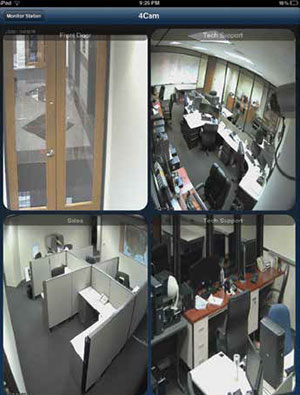
Video Surveillance On The Go
The necessity of a fully functional Web Client and Mobile VMS
- By James Whitcomb
- Feb 07, 2013
 After investing thousands of dollars in a
video management system, it’s important to
be able to maintain the level of features you
have access to from a monitor station, such
as making video clips, zoom and mapping.
After investing thousands of dollars in a
video management system, it’s important to
be able to maintain the level of features you
have access to from a monitor station, such
as making video clips, zoom and mapping.
When implementing a video surveillance
system for your business, it is essential to have a
feature-rich video management software (VMS) application that
is robust, yet easy to use. Installing a VMS monitor station at
work stations throughout an entire building or campus is key. In
many cases, large scale facilities, such as colleges or school campuses,
have monitor walls and security centers dedicated solely to
video surveillance.
Our fast-paced environments, and the need to be in several locations
at once, including off campus or out of the office, means a
VMS needs to not only be accessible from virtually anywhere, but
also reliable. The Video Insight VMS provides virtually the same
application for end users who log into the Web Client or use the
VI Mobile iTunes iPad and iPhone app on the go, as it does for
those who use Video Insight at a computer station.
Web Client
Providing a secure, highly functional Web-client application is essential
for a VMS, which is often the only application that many
will use.
A navigation tree should have easy access to cameras and servers.
A benefit of WebClient 5.0 is that it is easy to use, and has
an incredible array of features not often found via Web access
including:
- Live and recorded video from any server
- Video Clipping
- Quick search
- Mapping
- Playback integrated with Live Control
- Optional ActiveX Control
- Load balancing
- Active Directory and LDAP authentication
- Can be used with any browser
These capabilities are crucial for those entities that have a
great number of remote VMS users, such as the Austin, Texas,
Independent School District, which has 124 campuses across
230-square miles, 11,000 employees and 86,000 students. Austin
ISD has a 3,000-camera, 50-server video surveillance system and,
after using a different VMS provider, switched to specifically use
Web Client.
Under their previous VMS system, the district used a Thick
Client that had to be physically installed on each PC. With the
large number of users in this district, this was an almost full-time
job for the VMS administrators.
“We needed something that didn’t require an incredible
amount of CPU processor power and that could also serve as
a fully-functioning web-client,” said Wayne Russell, Austin ISD
Police Department representative.
An organization as large as Austin ISD requires a dependable
VMS to provide monitoring of facilities and students, and the ability
to review incidents and make clips in an easy and rapid fashion.
School districts of this size, move employees from campus to campus,
which means the VMS administrators spend a lot of time with
user maintenance. A reliable Web client is more economical than installing and uninstalling thick VMS clients on each PC, which
also overburdens the already taxed VMS administrators.
Use of the VI Web Client has made the Austin ISD VMS more
reliable and efficient, Russell said.
Mobile Apps
The Web Client will always be a regularly used feature of VMS,
but with the rapidly growing number of smartphones and tablets,
it has been crucial that video surveillance companies provide quality
and dependable applications to access video via these devices.
The VI Mobile App from iTunes—and the ability to use Video
Insight from Android devices—allows users an array of features
and the ability to use the VMS from anywhere.
The mobile App features live and recorded video from any
camera with control PTZ, active directory login, login to independent
systems with unique credentials, alarm logs and motion
alarms viewing.
Because the VI VMS is used by more than 25,000 school and
college campuses, it’s essential for campus security to have access
to live and recorded video at a moment’s notice, from anywhere.
Northeastern A&M College in Miami, Okla., has praised the
Mobile VI App because security officers rely on it so much.
As part of their routine patrol, officers drive golf carts around
campus. They stop outside of each building and, using an iPad
and the VI Mobile App, call up cameras inside of each building.
If they view anything suspicious, only then will they enter the
building. This approach increases the officers’ safety in the event
of a potentially hazardous situation, as the officers can access
the cameras and see what is happening inside before entering a
building unaware.
Ensuring Complete Coverage
If you are in the market for a VMS, or are considering an upgrade,
be sure to evaluate the system’s Web Client and Mobile
App prior to purchase as more and more endusers rely on the
ability to access cameras and important features on the go.
This article originally appeared in the February 2013 issue of Security Today.